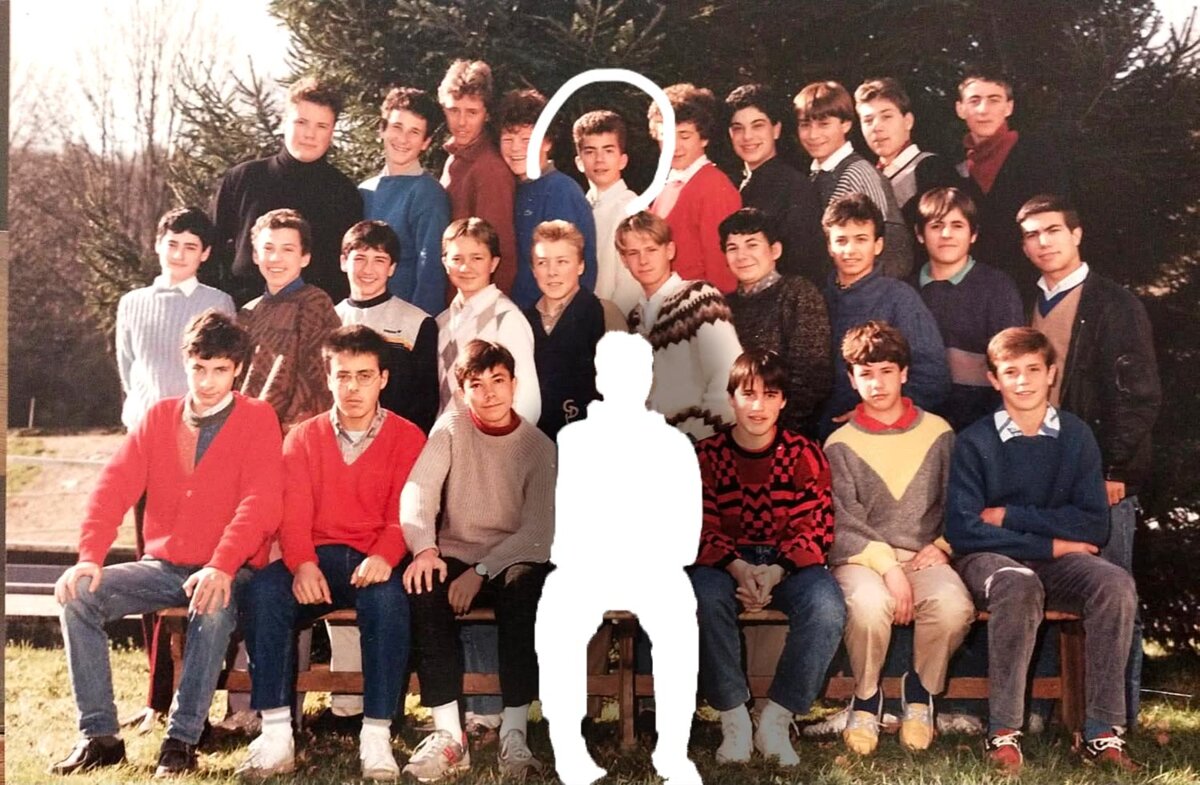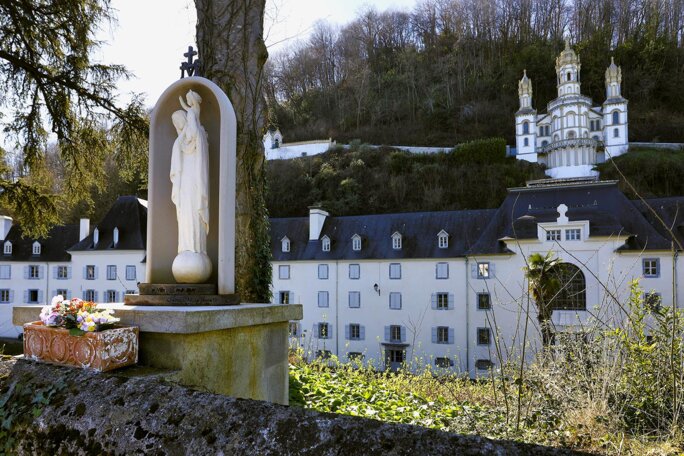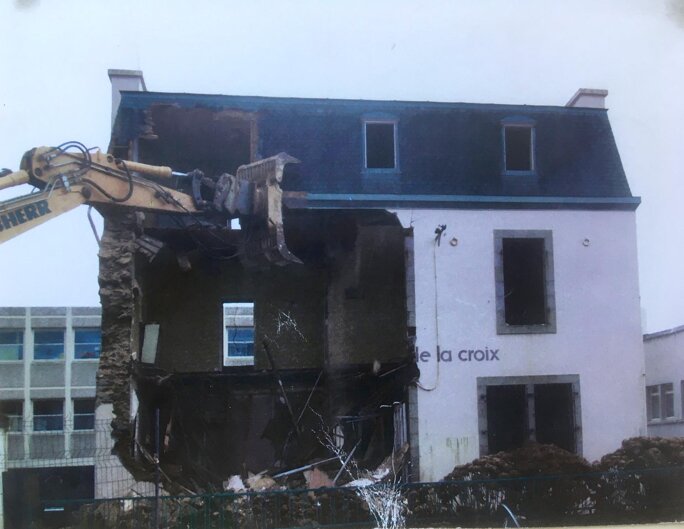Olivier Codet first met N. in the playground of Notre-Dame-de-Bétharram private Catholic school in south-west France in September 1985 on his first day in Year 10. It marked the start of a year “in hell”, but also of an “unbreakable friendship”. “We were both a bit of a mess, our parents were sure it would do us good,” recalls Olivier, now 55 and a teacher in the Bordeaux area.
At Bétharram, the violence began as soon as lessons ended. “We got beaten a lot by the three blokes who ran the boarding house – they were like kapos,” says Olivier. “Slaps in the face, for anything or nothing. I saw lads weighing 40 kilos knocked flying across the floor…”
Olivier says he quickly decided to “keep his head down” to maximise his chances of being brought home to Bordeaux after the end of Year 10. “N. tried to stand up to them. He ended up getting it even worse,” he recalls.
Alongside the daily blows, Olivier tells of the bullying and the put-downs, the hours spent standing in the courtyard “in front of the Virgin” in the freezing cold, and the torment of “morning wake-up”. He says: “If there’d been any noise in the dorm during the night, the wardens would bang on drums and wake everyone at five in the morning. Then we had to stand still at the foot of our beds for up to an hour and a half, with full bladders. Some lads would end up pissing themselves.” And they were only allowed one shower a week.

Enlargement : Illustration 1

“The trouble was, we didn’t go home in the evening, so we had this never-ending burden of violence we couldn’t get away from,” Olivier says now. At the end of Year 10, both friends were brought back to Bordeaux by their parents. “We weren’t at the same high school, but we stayed close,” says Olivier, who points out that he was lucky to be back in his own surroundings and his hockey team. “N. came back with a Vietnam war syndrome, they'd broken him into bits,” he adds quietly.
The two lads never spoke of that year again. “We messed about like teenage boys,” the former school boarder remembers. “N. rode a motorbike and played tennis, he was a good-looking lad, but things never went right with girls. He had highs and lows.” In his final year at school, he took his grandfather’s rifle from the garage and turned it on himself. “It wasn’t just a life ruined – the whole family was wrecked,” says his friend.
After that, Olivier says he “wiped the slate clean” and left the south-west of France. How many former Bétharram pupils did not survive the physical and/or sexual violence they endured there? “No one knows, but it seems a lot – far above average anyway,” says the scandal's whistleblower Alain Esquerre.
Erased from the public narrative
For example, on the former pupils’ Facebook group, the name of young V., who died in 1995 aged 14, crops up several times. “He was in my class, with Calixte Bayrou [editor's note, son of the prime minister François Bayrou who has denied claims he “failed to act” over the scandal as education minister],” says Éric Arassus, member of the Bétharram victims’ group, who says he came across several suicides during his three years at the school. The suicide of V., a “cheerful and friendly” lad, left a “deep mark”. “The whole class went to his funeral, it was really moving, but we got no support at all. It was brushed aside,” says Éric .
In the school’s magazine, an obituary paid tribute to the teenager. “He was going to turn 15 in a few days,” it reads. “He left us suddenly, experiencing in his own way his meeting with the Lord.” “V. took his secret to the grave,” wrote Father Vincent Landel.
Twenty years later, no one would dare claim a single, clear link between that suicide and the widespread violence at the school. Yet how can one not see a connection? Since the scandal broke in February, the names of former pupils who have died haunt the online forums run by survivors from across France, from Béarn in the south-west to Le Relecq-Kerhuon in Brittany, and to Abondance in the French Alps.
But these victims, those who suffered the most, are no longer here to speak. While voices have emerged from all corners to talk about the schools scandals, these ultimate victims have become invisible in, if not fully erased from, the narrative portrayed in the media and in the political world. What, then, of the suffering of those who died from what they went through?
In order that this story of systematic violence in Catholic schools is not told without them, Mediapart has sought out loved ones willing to speak of a brother or a friend, in the belief that the violence they endured in childhood played a part in their suicide or early death. Many of these relatives and friends had doubts. “How could one tell?” they asked.
They also wondered: “Who am I to speak for the dead?” One witness made her choice in the end. “I'm speaking for my brother to maintain his reputation,” says Céline. “And, in a way, to return it to him.”
Lack of figures
The National Assembly’s inquiry into abuse in schools itself admitted that there are no figures on this particular issue. In its final report, published on July 2nd, only one suicide is expressly mentioned. That was of Romain, a 14-year-old in a children’s home at Riaumont in northern France, who took his own life in 2001 after reporting tortures, including “fork stabbings”, according to the regional newspaper La Voix du Nord.
Back in 2021, after three years of work, the Commission Indépendante sur les Abus Sexuels dans l’Église (CIASE), said almost nothing on suicides in its report on sexual abuse in the Church. “I don’t recall us trying to count them,” confirms its former head, Jean-Marc Sauvé.

Enlargement : Illustration 2

Their main aim, he says, was to help the living. And in any case “a suicide never has one cause,” Sauvé says. “Nonetheless, we were aware that the sexual assaults on the children caused such distress that some of the victims never got over it.”
Still moved, the former head of CIASE remembers that several victims who had wanted to give evidence never turned up. “I’d like to believe all those deaths were from natural causes, but I’m not sure…” he says.
The head of the reparations and recognition body, the Instance Nationale Indépendante de Reconnaissance et Réparation (INIRR), set up by the Church after CIASE's findings, says that since 2021, two men who had begun the recognition process took their own lives before it was finished. For the French dioceses, 22 case workers handle the interviews. “We take great care,” says INIRR's president and children's rights expert Marie Derain de Vaucresson. “When we see that the person is in urgent need, we point them towards a trauma specialist who assesses […] the suicide risk, and we speed things up when necessary.”
The problems kept piling up: drink, drugs, depression, even jail.
Christophe himself never had the chance to begin this process. In 2011, aged 55, he was found unconscious on his bed “having taken too many pills”, says his sister Céline, a nun and doctor of theology. “I didn’t feel sorrow . I didn’t love my brother, I had no reason to.”
For his younger sister, Christophe only ever inspired fear. “My first childhood memory, I must have been three or four, is of strange noises in the flat: my father and my brother rolling on the floor, fighting.”
At the time, Christophe had just spent two years boarding at the Sainte-Croix-des-Neiges middle school, an establishment in the Alps under the auspices of the Nanterre diocese in the Paris region, where boys, often from “good families”, were sent for discipline and mountain air. For decades in those chalets, according to recent allegations now in the hands of prosecutors, staff carried out repeated rapes, beatings and acts of humiliation.
Christophe had repeated a year in Year 8, before returning to his home in the Paris region without telling anyone what had happened. “I don’t think he ever finished school,” says Céline. “The problems kept piling up – drink, drugs, depression, even jail.” This prison term followed serious violence committed on people close to him.
“He was very edgy, over the top, it was hard to talk with him,” Céline adds. “Near the end, he was very sick and took lots of medicine.” He was virtually a “zombie”.
Christophe turned the violence on himself and others.
Some time before his death, Christophe, then in his fifties, emailed his mother to say that he had been “raped by the priest” at Sainte-Croix. “She didn’t say anything to me at the time,” says Céline. “It was only after Christophe died in 2011 that she spoke to me about the email. But I didn’t believe it. He was a liar, I filed it under ‘lies’, in a little box.” One that she locked away for years.
Then in 2021, while researching CIASE’s work, the nun came across some videos posted by the commission. “Men in their sixties were speaking of the abuse and their lives since; that was Christophe’s life! Suddenly I understood. Since that moment, I’ve been certain of it.” Certain of the rape, first of all. But also of the “fact that the violence he suffered ended up killing him”, whether it was “suicide in the strict sense or not, whether he took too many pills on purpose or not”.
“That moment with the videos was heart-rending,” she goes on. “Until then, he was a bad guy. And then suddenly, it wasn’t quite that: he had been made bad. I had to reconstruct how I viewed it all.”
Before the Bétharram affair even broke, Céline had begun looking into Sainte-Croix and tracked down former pupils who remembered Christophe as a “really kind lad”. Above all, by uncovering the “mould of submission” forced on boys at a school whose motto was “trust and charity”, she realised just how much her older brother had “turned that system of violence on himself and others”.
The Church’s responsibility
In May, Christophe’s second wife, with whom Céline had not been in contact for ten years, posted on the former pupils’ Facebook group. “She told me things I hadn’t known: I thought Christophe had been enclosed in silence his whole life, but it seems he'd spoken to our parents [editor's note, before the email]. That changes the story a bit, as it may have deepened his bitterness…”
Just before his death in 2011, he had also written to the public prosecutor – the police summons to give his evidence came two months too late.
Today, Céline wants the Church to “see this through”. She says: “It’s not about fighting like Joan of Arc – especially since 2021, things are no longer as hush-hush or treated as something infantile. But once things are out in the open, they mustn’t be covered up again. That second silence is a new wound.” She adds: “What I’m experiencing now is a way of loving him”.

Enlargement : Illustration 3

In its 2023 report, the Commission Indépendante sur l'Inceste et les Violences Sexuelles faites aux Enfants (CIIVISE) stressed the long shadow that is cast by such trauma. “Without proper care ... very deep suffering … may last a lifetime”, it noted. This independent commission on incest and sexual violence against children pointed to findings from a 2017 health study: people who suffer sexual violence before the age of 15 are twice as likely to experience depression within a 12-month period. As for male victims, they are five times more likely to attempt suicide during their lives (see our interview, in French, with psychiatrist Thierry Baubet).
To show the scale of the issue, CIIVISE even gave a figure for the cost of the “additional suicide attempts” linked to sexual violence in childhood: 73 million euros a year.
But there is still a lack of research looking at the full cost of all forms of violence at school, not just sexual, but physical and mental too. Indeed, former pupils of the Saint-Pierre middle school at Le Relecq-Kerhuon in Brittany – whose headmaster long backed “pedopledgy” (a way of teaching through beatings) – decided to launch their own study. It shows that 70% of victims report social avoidance habits, 65% suffer from depressive moods, 16% have a drink problem, and 12% have an addiction to drugs. Here, too, the study shows that some former pupils have taken their own lives in ways that raise difficult questions for those left behind.
After a party in Brest, I dropped him home. When I came back the next day, he’d put a bullet in his head.
“It was a penal colony,” says Françoise, whose younger brother, another Christophe, was a pupil at Saint-Pierre in the late 1970s. “Our dad was quite tough, and even though he was a Communist, he decided to send him there to 'make a man of him’. I saw him come back with bruises, a swollen ear… I remember it upset me.” Their mother, a practising Catholic but very protective, managed to pull her son out. “I feel like he came back a bit broken, with a hatred of school and of himself. After that, everything was hard,” recalls Françoise.
At the age of 35, during the heatwave of 2003, Christophe was found hanging in the stairwell of the building where he lived near Paris. In a letter, he wrote that life had been “unbearable for years” and asked that someone look after his cat. “He took his secret to the grave, and maybe it had nothing to do with it [editor's note, with his school experience],” says Françoise, who now lives at Quimper in Brittany. “Suicide is also about who you are, there are people with grim lives who never think of it… But I’ve always thought the two were linked.” She feels sure that, at the very least, the beatings left him more brittle.
She has also spoken with Jean-Paul, another former Saint-Pierre pupil, who, too, sees a link between the abuse and the suicide of one of his closest mates, 'Alain' – not his real name – at the age of 23. It was one night in 1986. “I dropped him home after a party in Brest [in Brittany, west France],” he says. “When I came back the next day, he’d shot himself in the head with his dad’s rifle. He’d left a note saying they would never understand each other. His father was already an old man, the type who worshipped the Germans and the war. So there was discontent at home.” But he says that “Alain got battered” at Saint-Pierre and that “this can only have made things worse”.
This was made even worse by the fact that his father's ideas and those of the school's headteacher, Abbé Yvon Laé, a man said to be obsessed with the Nazis, seemed to match. “In the yard, the brazier where we burnt papers was called the 'cremation oven’,” recalls Jean-Paul, who speaks of “grim teaching methods”. “When we came out of that place, we were all scarred – drinking too much, taking mad risks.”
Now part of a group of former pupils, Jean-Paul speaks out not just to “heal” himself, but also “for my mates”. In order to help rescue them from their phantom-like status.
-------------------------------------------------------------------------------
- The original French version of this article can be found here.
English version by Michael Streeter


